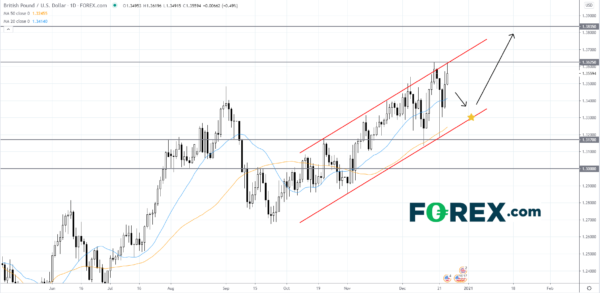The US Dollar was bearish against most of its major pairs on Thursday with the exception of the CHF and JPY. On the US economic data front, no major economic data was released.
On Friday, US markets will be closed to observe Christmas Day.
The Euro was bearish against most of its major pairs with the exception of the CHF and JPY.
The Australian dollar was bullish against most of its major pairs with the exception of the GBP.
Regarding the week’s U.S. economic data front:
The Mortgage Bankers Association’s Mortgage Applications rose 0.8% for the week ending December 18th, compared to +1.1% in the week before. New Homes Sales tumbled to 841K on month in November (995K expected), from a revised 945K in October. GDP rose to +33.4% for the third quarter third reading (+33.1% expected), up from +33.1% in the third quarter second reading. Existing Homes Sales slipped to 6.69 million on month in November (6.70 million expected), from a revised 6.86 million in October.
Durable Goods Orders increased 0.9% on month in the November preliminary reading (+0.6% expected), compared to a revised +1.8% in the October final reading.
Initial Jobless Claims dropped to 803K for the week ending December 19th (880K expected), from a revised 892K in prior week. Continuing Claims unexpectedly fell to 5,337K for the week ending December 12th (5,560K expected), from a revised 5,507K in the previous week.
Personal Income slipped 1.1% on month in November (-0.3% expected), compared to a revised -0.6% in October. Personal Spending declined 0.4% on month in November (-0.2% expected), compared to a revised +0.3% in October.
The University of Michigan’s Consumer Sentiment Index fell to 80.7 on month in the December final reading (81.1 expected), from 81.4 in the December preliminary reading.
The Conference Board’s Consumer Confidence Index dropped to 88.6 on month in December (97.0 expected). from a revised 92.9 in November.
Looking at a daily chart, the GBP/USD currency pair appears to be rising within a bullish channel that began to form in October. The simple moving averages (SMAs) are arranged in a bullish manner, as the 20-day SMA is above the 50-day SMA. The pair appears to have halted at last weeks high of 1.3625. The pair will likely pull back towards the lower trendline of the channel around the 50-day SMA and bounce. If the pair bounces then it will probably rally to retest the 1.3625 resistance level. If the pair can get over 1.3625 then its next resistance level would be 1.3835. On the other hand, if the pair fails to be supported at the lower trendline it would be a bearish signal that could send price action back to 1.3170. If the pair cannot rebound off of 1.3170 it could dip back to 1.3000.


 Signal2forex.com - Best Forex robots and signals
Signal2forex.com - Best Forex robots and signals




